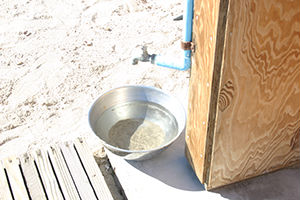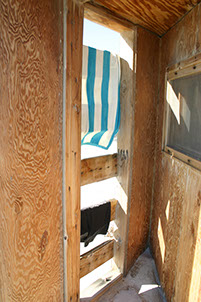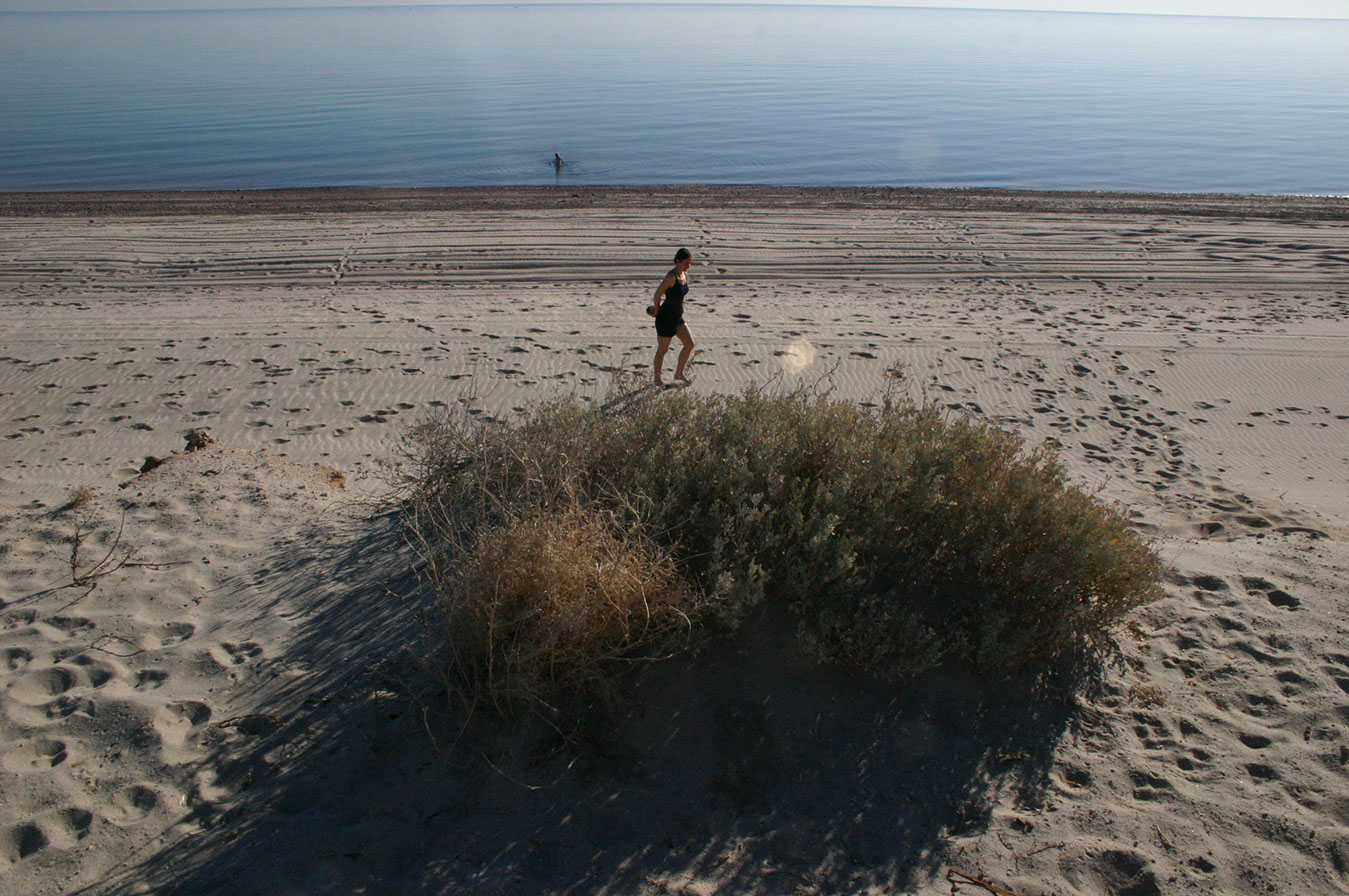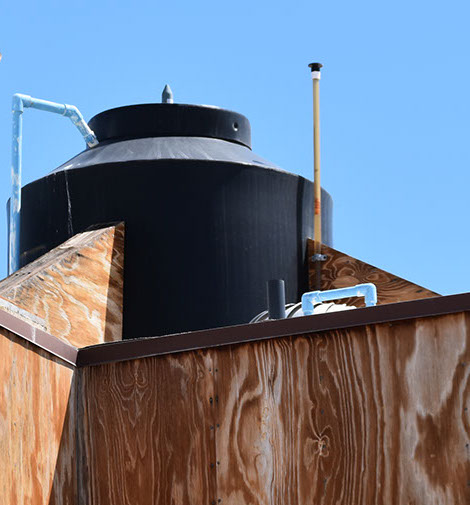VISITING THE CUBE
Enjoying Your Stay
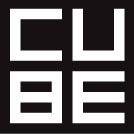
To keep your visit trouble-free, there are three essential things to monitor during your stay.
1
Monitor solar energy The Cube is an off-grid building. The photovoltaic system is located in the shed to the West of the Cube, and it requires daily monitoring. Access to the shed is gained by using the padlock key in which is found in the lowest small wooden drawer to the right of the stove, (The same key is for the lock on the propane hutch).

Two padlocks holding two overlapping steel bars secure the shed door.
Remove and discard the electrical tape which has been placed there to prevent blown sand from fouling the locks. Once the padlocks spring open, remove them and set them aside. Turn the two hooks protruding from the door to horizontal position, making it possible to remove the steel bars. Slide the shed door open and stow the padlocks and bars inside.
23.0 is the magic number! You will need to check the battery voltage every morning at dawn. A small white box called a charge controller keeps track of the power coming from the panels and the power use from the batteries. The Cube’s charge controller is located on the dividing wall between the two halves of the shed. Its job is to regulate the flow of electricity from the panels so that the batteries are charged at the proper rate. When the batteries are full it will cut off the input from the panels. The green LED display gives a readout of amps and volts.
The voltage number at dawn should be 23.0 or above. If it’s lower than 23.0 it can cause damage to the batteries, so cut back on overnight use of electricity if this happens. If the battery level is too low the inverter will do an emergency shut down and turn itself on again when the voltage returns to normal. Don't rely on this function to keep the batteries within a safe range. During the daytime you can operate just about any electrical device except air conditioners, electric heaters and hair dryers. But be cautious when the weather is overcast.
AnytimeDaytime onlyNeverRefrigeratorLightsComputersFansPower toolsVacuum cleanerToasterMicrowaveAir conditionerDe-humidifierHair dryerElectric heater

2
Monitor water supply The main water supply at the Cube consists of three large sand-colored tanks located behind the solar shed. One of these tanks has vertical clear tubing attached to it with orange floating balls inside. These balls indicate the water level in all of the tanks. If the water level in these tanks falls below nine inches from the ground, send an email message! [link] On the roof of the Cube is a smaller black tank which holds water for daily use. This also has a water level indicator that is visible from the ground.
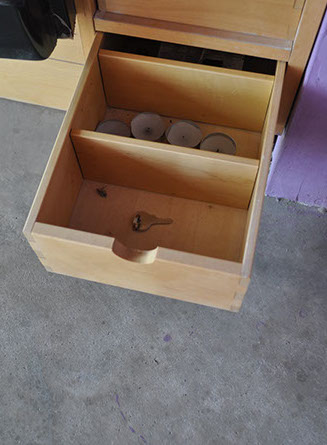
[left] Padlocked steel bars lock the sliding shed door. [above] The padlock key is always kept in the lower wooden drawer in the kitchen to the right of the stove
[below] The Cube's charge controller. The important number is the battery voltage in the upper right of the LED display. This dawn readout of 26.6 volts shows that overnight electricity use has been well below the safe limit

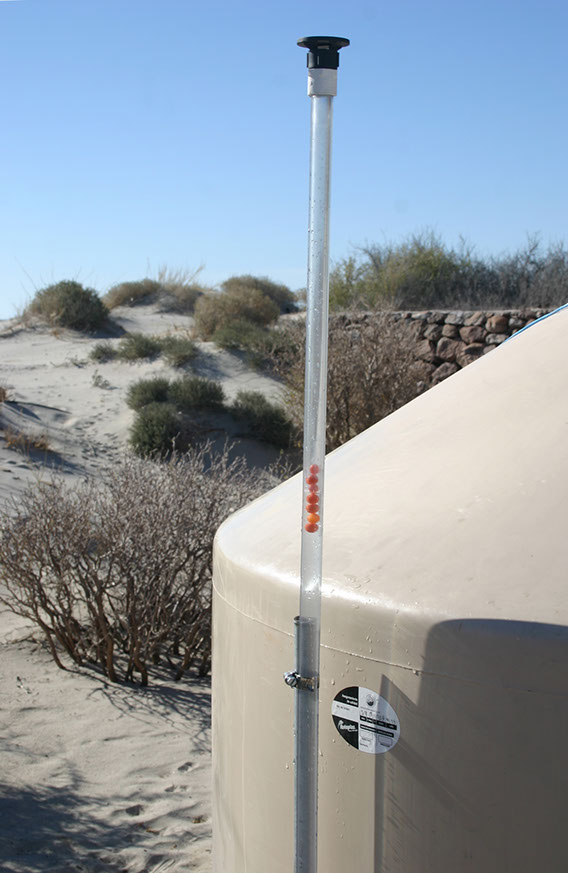
1
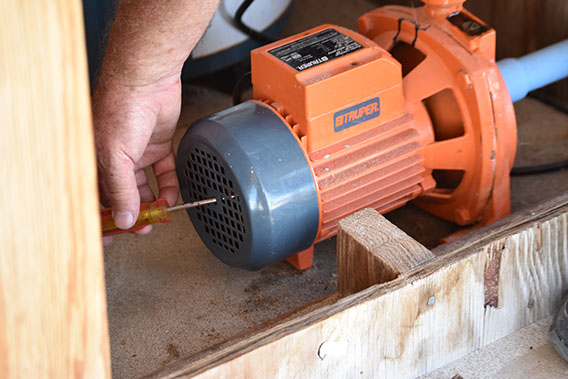
4
Refilling the roof tank When the water level in the roof tank is low you will need to pump more water into it from the main water supply three tanks. There is a water pump located in the hot water heater closet. To operate the pump, turn on the switch which is located on the wall to the right of the water heater. If the pump does not operate the motor is stuck from lac of use. You can free the motor by inserting a screwdriver into the hosing on the left of the pump and moving the fan blades. Tun off the pump when the level indicator on the roof tank shows it is full.
3
Monitor propane supply The propane tanks are housed in a small padlocked hutch attached to the West side of the building. The padlock key is kept in the lowest small wooden drawer to the right of the stove. The same key is for the locks on the solar shed. Stow the padlock inside the hutch after opening. Unscrew and stow the wingnut to open the right door. The upper shelf tanks are for the are for the stove and the bottom shelf tanks are for the water heater. After inspection keep the hutch doors closed because of wind. You can tell if a tank is getting empty because it is much lighter than the others. If the gas goes off, switch the paired tanks by moving the lever away from the empty tank and towards the full tank. Unscrew the empty tank (the threads are left handed) and have it replaced with a full one at the third store on the left in the village (about three miles North of the Cube on the main paved road). Exchange an empty tank for a full one at the store for about $15. More information can be found In Cube Systems: Propane.
Downstairs
Using the stove The stove has a spark ignition operated by a switch on the left of the control panel. The spark icon has worn off the switch button. The other button is for the oven light. The oven is lit by a gas lighter or match. There is a light above the stove. The switch is inside the window vent.
Drinking water The water in the roof tank is not safe for drinking or cooking so there is a water cooler on a pedestal near the bookcase. You can get drinking water bottles refilled in the village 3 miles north for about $1 for a 5 gallon container. The village of Delicias has very rudimentary groceries and hardware. (See Town and Village section for more information about obtaining provisions.}
Dining Cutlery and dishes, pots and pans are found in the kitchen drawers and cupboards, There are also paper plates. There is a tea kettle, coffee pot and grinder. The kitchen has a stock of staples—canned goods, rice, condiments, and teas. Be sure to replenish what you use up.
Windows and doors Open the sliding glass door by removing the wooden batten in its base. This batten must be replaced when you leave. It should also be there if you take a long walk on the beach or go into town and no one is home. The window above the sink hinges upward and can be kept open by hooking it to the ceiling beam.
Sleeping The futon will sleep two. Unfortunately it no longer raises to the upright position, but by arranging pillows it also serves as a couch.
Media The dividing wall in the middle of the kitchen is designed to house a 24 inch monitor. There are two extension speakers in alcove above. The back panel, which is held in place by screws, may be removed for access to wiring.
Screwdrivers and other tools are kept in a kitchen drawer near the sink. A row of outlets above the back panel provide power. A collection of CDs and DVDs are found in the small wooden drawers below the keyboard shelf. In the far corner by the front door is a small library. Internet service is also provided at the Cube.
Cleaning The concrete floor is quite forgiving of spills and leaks and can be kept clean with a broom which is usually stowed in an alcove behind the futon. Sand will tend to drift into the building propelled by occasionally strong winds. It will also accumulate on countertops and tables, and you may need to do a clean up on arrival if the building has been unoccupied for some time.
Trash There is a bin underneath a butcher block to the left of the sink. A towel is usually draped over a cable in front of the bin. Plastic trash bags are kept under the sink. Do not leave trash outside. You can store full trash bags in the shed until departure.
Upstairs
Bathroom There is a small bathroom with flush toilet and a sink in an alcove just outside. There is no door, but a curtain provides privacy. The shower enclosure has a flexible shower head that can be docked in stationary position. Separate hot (left) and cold (right) taps regulate the temperature and flow. Extra toilet paper is stored in the cabinet below the sink.
Closet There is a walk-in closet adjacent to the bathroom with room to stow your clothing items and suitcases. Additional bedding is stored here. There are also three small chests of drawers in the upstairs
Floor The unfinished plywood floor may cause splinters, so be careful when barefoot.
Stairs Caution: they are steep. Two sturdy hand rails provide balance. Be careful when carrying things up and down the stairs and always use the light in the stairwell at night-time. There is a low overhead opening at the bottom of the stairs and we have placed a wooden duck there to remind people over six feet tall to bow their heads when entering and exiting the stairwell.
Windows The heart, the circle and the star shaped windows have no glass and are normally left uncovered, but during cold or windy weather you can attach a plexiglass circular cover on the inside wall with screws. The plexiglass circles are stowed in the room with the heat shaped window, and the screws are kept on a shelf in an alcove in the same room. The screwdriver is in a kitchen drawer.
The large twenty pane window on the East side overlooking the Sea of Cortez is not openable.
Shutters two slatted openings in the wall, one above the bed, and the other in the closet provide cross ventilation. Insect screens help to reduce incursions from flying insects. Hinged shutters make it possible to control the amount of ventilation. Four openings in the ceiling below rotating roof vents provide extra cooling. Leaving the roof hatch open will give yet more ventilation, but be careful to prop it open with the wooden batten attached to the inside of the hatch.
Outside
Porch The North porch provides an outdoor area sheltered from the sun and wind, and is a nice place for outdoor eating. The bench seats lift up. There you will find a portable grill and supplies and a collection of water shoes. There are also cushions. In the Summer the porch bench can serve as an outdoor sleeping platform. A folding table is kept in the shed for use in the porch.
Firepit There is a rudimentary firepit surrounded by cement blocks directly in front of the building.
Beach access A short climb down the sandy berm in front of the Cube gets you to the beach quickly. There is a also gentler ramp to the North. In summer the sand will get very hot, so sandals are recommended. Most of the time the beach is deserted, but during Spring break and other holidays there will be some dune buggy traffic and suchlike boisterous activities.
Safe swimming Swimming is best at high tide. The beach slope is quite steep, so watch your footing when entering and leaving the water, especially when the sea is choppy. Fortunately there are rarely any large waves to knock you down.
Calm seas occur quite often, and it is very enjoyable to float in the warm water during most of the year. At low tide a large reefy area is exposed and beyond that a sand bar. It's best to wear water shoes to protect your feet from sharp rocks and the occasional stingray that may be lurking in the sand.
Outside water supply We recommend placing a bucket or bowl under the tap at the Southeast corner of the building to wash sand off feet before entering the Cube from the outside. When the building is unoccupied the gravity feed water supply is turned off from the roof tank to prevent pilfering. To enable to water supply go up to the roof and turn the red ball valve with black electrical tape 90°.
Drying towels You may find it convenient to place wet towels over the wooden slats on at the southeast corner of the building outside the kitchen window.
Parking area It is possible to park either at the West side or the North side of the building. At certain times of the year drifting sand will accumulate on the parking area. If you should become stuck in a sand drift in the parking area, remember that there is solid brick beneath it and you may extricate yourself with patience and a shovel.
PUMP NOTES
The pump replenishes the roof tank at a rate of 2.5 inches per minute. At the same time it depletes the 2,000 gallon tanks at a rate of 0.75 inches per minute.

[above] The four propane tanks in the hutch on the West side of the Cube. Wrenches and lubricant are kept her, too. The right door is fastened with a bolt and wingnut—be careful to set them aside on a shelf

[above] The compact but well-appointed kitchen
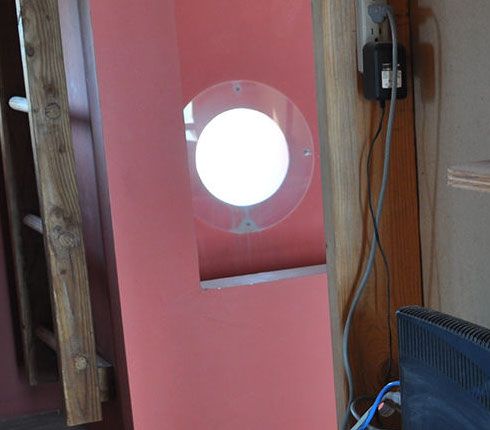
[above] A removable plexiglass cover screwed to the wall surrounding the West circle window.
[below] For dining at the North porch you will need to set up the folding table stowed in the shed
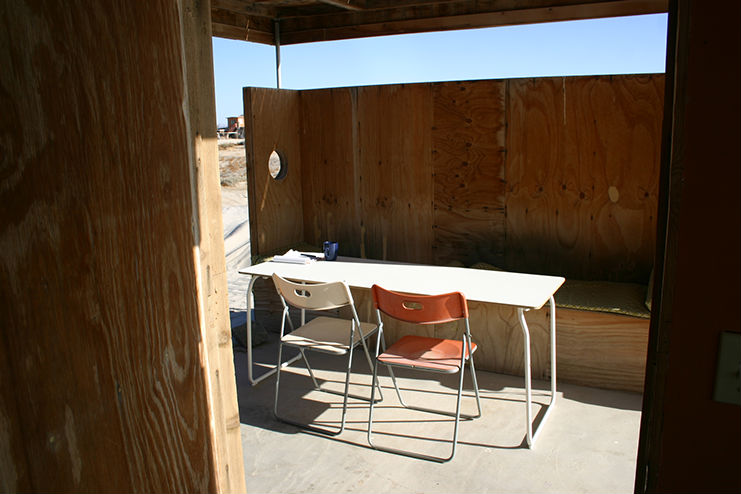

[above left] The shutoff valve for the outside water tap in closed position [above right] A bowl for washing sandy feet under the outside water supply tap [right] Drying wet beach items on the slats [below] Safe swimming in a calm waters in front of the Cube
